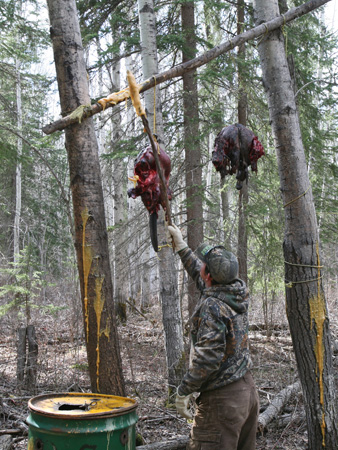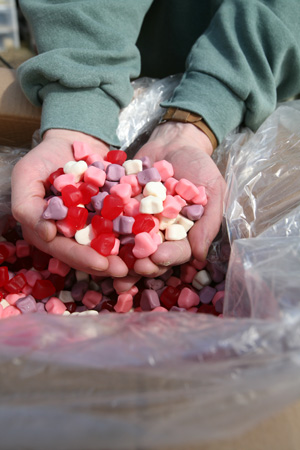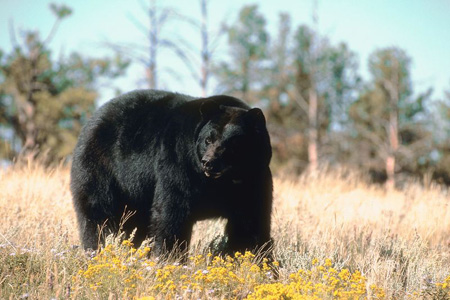Blunder 1:
Picking A Bad Bait Site
You can whip up the most tempting baits in North America, but if they aren’t situated along traditional travel routes, you’ll see few bears and even fewer book bears. After all, who thinks “any tree, anywhere” when they’re after trophy whitetails? Likewise, it’s imperative to do everything possible to bump the odds of intercepting bears.
It doesn’t matter if I’m hunting Arizona or Manitoba, I can’t expect my baits to re-route nomadic bears; I’ve learned the hard way to set up along natural corridors the animals like to use when traveling from Swamp A to Ridge B. Baits within a traditional line-of-travel always heat up quicker and keep bears hanging around longer.
 An essential ingredient of all of my hunts is a creek bottom; bears drink a lot of water and prefer the coolest temperatures and densest vegetation available. So think creeks and ridges when studying topographical maps to help prioritize potential bait sites. Then and only then are you ready to scout for tracks, fresh scat and tree markings. Once you find the sign you’re looking for, set up close, but not too close, to clear-cuts and woods opening, where bears feel safe because they don’t have to expose themselves.
An essential ingredient of all of my hunts is a creek bottom; bears drink a lot of water and prefer the coolest temperatures and densest vegetation available. So think creeks and ridges when studying topographical maps to help prioritize potential bait sites. Then and only then are you ready to scout for tracks, fresh scat and tree markings. Once you find the sign you’re looking for, set up close, but not too close, to clear-cuts and woods opening, where bears feel safe because they don’t have to expose themselves.
Blunder 2:
Ignoring Natural Food
Brian Bachman chairs the North American Bear Foundation (www.nabf.org) and runs a popular bear camp in northern Minnesota. He admits bears enthusiastically consume just about anything, but they have definite preferences. So why not start with what they’re already eating, he asks.
“Early in the spring, look for the first signs of green-up,” says Bachman. “Later on, concentrate on lush vegetation. If it’s on the menu it won’t be a mystery, because bears [defecate] a lot and make a trampled mess wherever they’ve been feeding heavily.”
Manitoba outfitter Ed Balan (E & D Outfitters; 204-234-5531) is dogmatic when it comes to starting a bait site and keeping a trophy in your hunting area. “Nothing beats beaver,” he insists. “I think it’s the castors [perineal glands] bears go for. I do my own trapping, but you can buy beaver carcasses for next to nothing and store them in the freezer till you’re ready to go hunting.”
In some provinces, such as Ontario, fish can be effective (fish are illegal in states like Wisconsin, so check local regulations). I discovered this when I set up a bait near an inlet that attracts spawning suckers. Talk about constant bear traffic…
Blunder 3:
Focusing On The Bear’s Sweet Tooth
While some bears appear to be infatuated with carbohydrates such as pastries, Jell-O and candy, empirical evidence suggests that meats, grains and fats are more effective over the long haul. Why? Because these food sources enable bears to pack on weight quickly, whether they’re emerging from a den or storing up for the winter.
Grease is great. It’s widely available (many restaurants and fast-food chains change oil supplies daily), and it’s handy (mixes conveniently with wheat and oats in a five-gallon bucket). Moreover, get grease on the pads of baited bears, and you’ll advertise your bait’s location to the rest of the clan.
Blunder 4:
Using Bait Gone Bad
Just because bears love maggots doesn’t mean they love maggot-infested meats. Quite the contrary, bears prefer fresh meats over rancid cuts that smell like death warmed over. Noted bowhunter Myles Keller has arrowed numerous monster bears in Minnesota and Canada, and he always ices down his bait supply in camp. “The older the boar, the more he can resist sweets and ‘fluff stuff,’” Keller says. “But lay out store-fresh meats, and you’ve got a good chance of winning the baiting battle.”
 If meat sources are limited or supplies are unreliable, a handy alternative, where legal, is a road-kill deer (bear feed heavily on fawns in the spring). To make this work, contact conservation officers with jurisdiction in your hunting area. Other options include game farms and farmers who must deal with stillborns.
If meat sources are limited or supplies are unreliable, a handy alternative, where legal, is a road-kill deer (bear feed heavily on fawns in the spring). To make this work, contact conservation officers with jurisdiction in your hunting area. Other options include game farms and farmers who must deal with stillborns.
Blunder 5:
Overfeeding Bears
To lure a book bear within bow range, you’ve got to coax him in during shooting hours. Sounds elementary, but it’s very difficult unless you “ration” the animal’s intake. If you fail to do this, odds are the bear will either hit your bait infrequently or arrive well after dark. Over-feeding accomplishes the opposite of what you’d expect.
“If you give a big boar too much to eat,” says Balan, “he’s likely to over-eat and disappear for a couple of days as he ‘works it off.’ In the spring he could get side-tracked by a sow in heat and never show up again.”
So how much bait is too much? Most savvy guides and outfitters measure their booty by 5-gallon buckets: about two buckets per day, per bear. “But sometimes I’ll take some bait back out with me after I hunt,” Keller says. “I don’t want any bear thinking he can bank on a free meal. I want to give him just enough to become dependent on me, not me dependent on him.”
Blunder 6:
Using Fall Tactics In Spring
Oh, how I wish this were true. What makes spring baiting so temperamental is that it overlaps the mating season. Sows can ruin a hunt or save it. It depends on the sow.
If a sow with young cubs visits your bait, you’ve got trouble. If she’s one of the dominant females, she could fight off the competition, including mature boars. You’ll have to switch to a different bait while hoping she reappears next year—this lactating lass won’t go into heat again until next spring.
Conversely, the best spring insurance is a lonesome sow. A close second is one with yearlings tagging along (as she enters estrus she’ll chase them off). Do whatever it takes to court these gals, because they can pull in dominant boars from miles around. Prime time is the end of May, but female bears, unlike deer, remain in estrus until they’re successfully bred.
What if you don’t get a good visual of the sows—how can you tell if they’re lactating or entering estrus? A good clue is the bait site. Small bear tracks and scattered piles of “leftover bait” are a dead giveaway: Sows with this year’s cubs like to cover surplus goodies with grass and leaves. Coincidentally, harvesting any sow, whether she’s with cubs or not, should be avoided at all costs.
Blunder 7:
Judging Bear Size By Tracks
If Pope & Young bears are your goal, you have to be able to differentiate baits visited by large bears from those visited by lesser animals. It’s simple in theory, difficult in practice. The so-called 5-inch-pad benchmark has long been an outfitter’s favorite, but it’s a general guideline, at best. A few years ago, for example, I measured five mature bears harvested at Dr. Peter Kalden’s camp at Davis Point Lodge in Manitoba. Only two were Pope & Young class, yet all five sported front pads exceeding 51/2 inches. (Kalden uses a unique “bear box” that’s very accurate for rough-scoring bear skulls).
 Further complicating matters is the fact that boars and sows are capable of growing large paws, yet only boars consistently score impressive skull measurements. A better sizing technique is the body-length estimation. “Tall” bears—measuring at least 51/2 feet from nose to tale—nearly always qualify for the record books. Larger, older boars also appear to have disproportionately small ears. It may help to lay 6-foot logs around your bait. When a bear passes by, you’ll get a quick snapshot of his relative size.
Further complicating matters is the fact that boars and sows are capable of growing large paws, yet only boars consistently score impressive skull measurements. A better sizing technique is the body-length estimation. “Tall” bears—measuring at least 51/2 feet from nose to tale—nearly always qualify for the record books. Larger, older boars also appear to have disproportionately small ears. It may help to lay 6-foot logs around your bait. When a bear passes by, you’ll get a quick snapshot of his relative size.
What about guesstimating midnight raiders? By far, the best way to judge unseen bears is by hanging fresh meat on a wire between two trees. Just make sure the trees are far enough apart to prevent bears from climbing either tree and swatting the meat down. Start by hanging the bait seven feet up and keep “raising the bar” till the bear can no longer reach it. Bears hitting the eight to 10-foot level are worthy candidates … although a few rascals can jump like LeBron James.
Blunder 8:
Neglecting Scent Control
Tales of bears obeying their stomachs and ignoring their noses are legendary but misleading. The mature boars I’ve dealt with possess a lot more self-control than, say, adolescent animals. I can’t count the times I’ve been circled by a boar and ended up waiting for nothing to happen. Simply put, these scoundrels know how use the wind, and if they smell you they won’t commit suicide. Again, don’t underestimate bears; do your scent-control due diligence.
Thankfully, odor neutralizers have experienced a short evolution. A good example is Robinson Outdoors’ White Lightning, a spray that incorporates a carbon-like substance that out-performs first-generation acid-neutralizing formulations. And Scent-Lok, pioneers of the odor-elimination clothing game, constantly tweaks the performance and comfort of their outer garments. That now includes ultra-lightweight clothing ideally suited to spring bear hunting. But in spite of these precautions, you might find yourself playing cat-and-mouse with a big bruin. Myles Keller taught me a slick trick many years ago, and it remains my go-to strategy for dealing with mature, experienced boars.
Start by wearing a camo shirt or jacket daily—when you mow the lawn, put out the garbage, clean the garage—over an extended period. Next, store the garment in a sealed plastic bag and place it inside a second sealed bag. You’re going to use this piece of clothing to get bears accustomed to your scent: Hang the garment from a stand near your bait site, remove it after every hunt, and replace it each time you return. (Keep this garment smelling “human,” while segregating it from the rest of your scent-free camo duds.)
Now you’ve got bears thinking you’re someplace you’re not, and you should be able to hunt from another stand. Set it up down-wind, about 50 to 75 yards away, and bears should circle up-wind of you. (Exactly where the second stand goes depends on the terrain and how bears tend to approach your bait. Ideally, take advantage of natural funnels, such as beaver ponds and lakes.) Be sure to follow this ritual to a “T” every time you hunt.
Blunder 9:
Underestimating The Little Things
If we ever catch Osama bin Laden, here’s how to get him to talk: Handcuff him to a treestand in bear country, and wait 10 minutes. Indeed, failing to de-bug yourself is inviting hordes of buzzing and crawling insects—from black flies and mosquitoes to no-see-ms and sand flies—to dinner. I live in the North Country, so I know what I’m talking about: You can’t swat bugs while sitting motionless on stand…
Take my advice and pack along the following: two head nets (a backup is a must); “bug clothing” (like Shannon Outdoors’ Bug Tamer); Mad Dog Gear’s Buzz Off odorless Insect Repellent Apparel comes in Mossy Oak’s New Break-Up pattern; hunter’s insect repellent (such as Robinson Outdoors’ No Stinking Bugs with DEET); tick repellent (like No Stinking Ticks with Permethrin); and duct tape (seal off sleeves and pant legs).
Blunder 10:
Failing To ‘De-Nocturnalize’ The Bear
Sooner or later your baiting game is going to end in a stalemate: Baits disappear, bears don’t appear. As in gun-shyness with dogs, prevention is the best medicine. First and foremost, avoid spooking bears, especially in the dark. This is the number-one cause of bears turning to the graveyard shift. Ironically, bumping bears during broad daylight isn’t nearly as traumatizing. Put it all together, and it boils down to your access strategies. Some tricks of the trade:
- Select and prepare bait sites for silent, low-impact access.
- Use night vision technology and binoculars while entering and exiting bait sites.
- Condition bears to a sound, such as a banging bucket, when coming and going. The sound of a distant four-wheeler also works.






